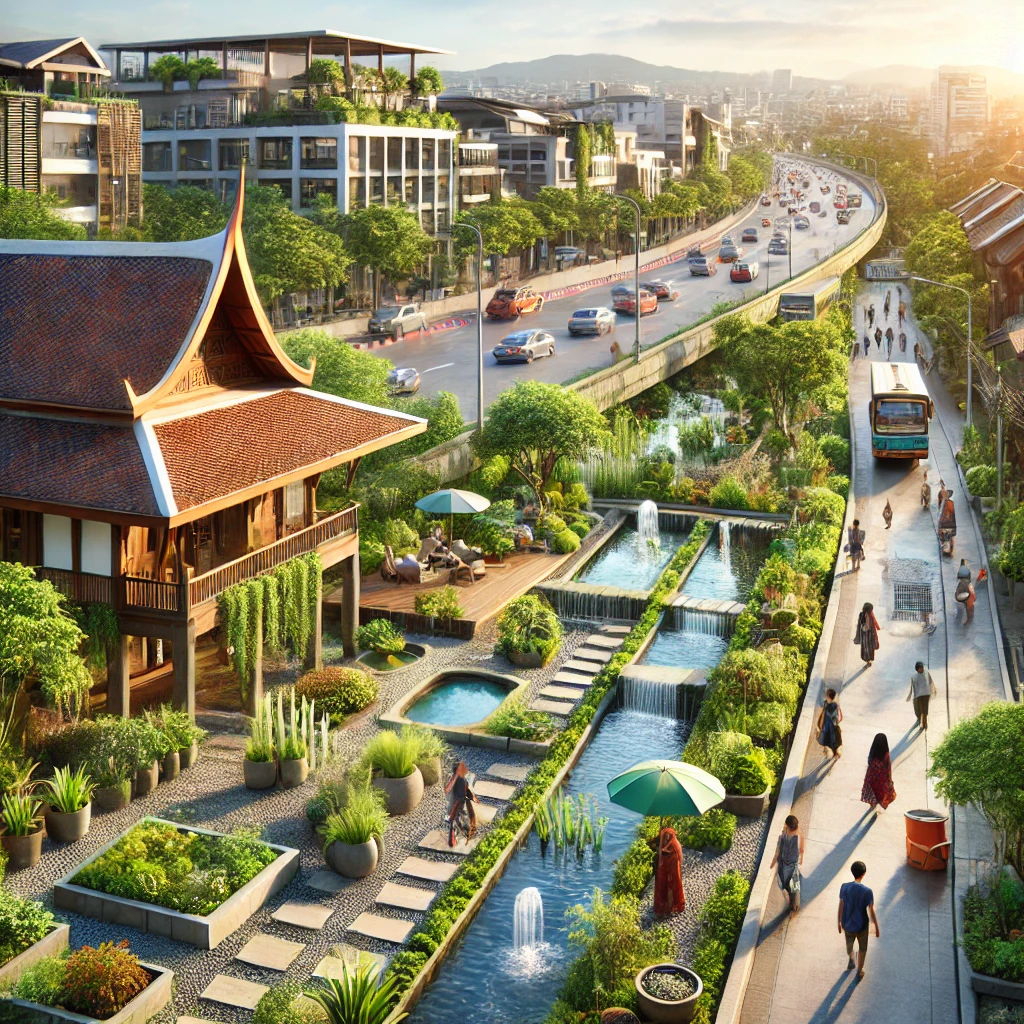Water Sensitive Urban Design (WSUD) is playing a transformative role in reshaping Chiang Mai’s urban landscape. This innovative approach is making the city greener, more resilient, and more sustainable by integrating natural water management systems into urban infrastructure. WSUD techniques, such as rain gardens, bioswales, and permeable pavements, effectively manage stormwater, reduce flooding, and improve water quality. These systems help maintain a natural water balance in urban areas, supporting biodiversity and reducing the urban heat island effect. By enhancing both environmental quality and urban livability, WSUD is ensuring that Chiang Mai not only meets the challenges of today but also remains a vibrant, sustainable city for future generations.
Transforming Chiang Mai’s urban landscape, making it greener, more resilient, and sustainable. By integrating natural water management systems into the city’s infrastructure, WSUD enhances environmental quality and urban livability.

Key Improvements and Outcomes
1. Stormwater Management and Flood Mitigation
WSUD practices in Chiang Mai have led to a dramatic reduction in stormwater runoff, which has traditionally been a significant challenge in the region. By incorporating permeable pavements, rain gardens, and bioswales, the city effectively manages heavy rainfall, preventing flooding and reducing pressure on the urban drainage system. These features allow water to infiltrate the ground, replenish aquifers, and decrease the risk of flash floods, contributing to a more resilient urban environment.
2. Enhanced Water Quality
The integration of WSUD features like biofiltration systems and constructed wetlands has resulted in substantial improvements in water quality in Chiang Mai’s rivers and canals. These systems filter out pollutants from stormwater runoff before it reaches natural waterways, reducing contamination levels and promoting a healthier aquatic ecosystem. The improved water quality supports a diverse range of plant and animal life, enhancing the overall biodiversity of the city.
3. Urban Biodiversity and Green Spaces
WSUD has also led to an increase in green spaces throughout Chiang Mai, which play a crucial role in supporting urban biodiversity. Rain gardens, green roofs, and vegetated swales not only manage water but also provide habitats for various species of plants, birds, and insects. This integration of green infrastructure into urban areas helps maintain ecological balance and supports a diverse ecosystem within the city, creating a more vibrant and environmentally friendly urban landscape.
4. Mitigation of Urban Heat Island Effect
The proliferation of green infrastructure, including green roofs and tree-lined streets, has helped to mitigate the urban heat island effect in Chiang Mai. These features lower ambient temperatures by providing shade and cooling through evapotranspiration. As a result, the city experiences reduced heat stress, leading to more comfortable living conditions for residents and lower energy consumption for cooling buildings.
5. Aesthetic and Recreational Benefits
The aesthetic appeal of Chiang Mai’s urban environment has been greatly enhanced by the implementation of WSUD. The incorporation of green and blue infrastructure, such as beautifully landscaped rain gardens and serene water features, has transformed the city’s streets and public spaces. These improvements not only make the city more attractive but also provide residents with recreational opportunities and a greater connection to nature. Parks and open spaces designed with WSUD principles offer areas for relaxation, exercise, and community gatherings, enriching the quality of urban life.
6. Community Engagement and Awareness
The visible impact of WSUD projects has raised community awareness about sustainable water management practices and the importance of environmental stewardship. Educational campaigns and public engagement initiatives have encouraged residents to participate in water-saving measures and support the maintenance of green infrastructure. This community involvement fosters a culture of sustainability and collective responsibility, ensuring the long-term success of WSUD initiatives in Chiang Mai.
7. Economic Benefits
The adoption of WSUD has also brought economic benefits to Chiang Mai. The reduction in flooding and water damage has decreased the costs associated with stormwater management and infrastructure repair. Additionally, the enhanced attractiveness of the urban environment has boosted tourism and local business, contributing to economic growth. The investment in green infrastructure creates jobs and supports the local economy, providing long-term financial stability for the city.
8. Climate Resilience
WSUD practices have made Chiang Mai more resilient to the impacts of climate change, such as increased rainfall intensity and temperature fluctuations. By incorporating adaptive water management strategies, the city is better prepared to handle extreme weather events and mitigate their effects on urban infrastructure and ecosystems. This resilience ensures that Chiang Mai can sustain its growth while maintaining environmental integrity and protecting its residents from climate-related risks.
Conclusion
The impact of Water Sensitive Urban Design on Chiang Mai’s urban landscape is profound and far-reaching. By integrating sustainable water management practices into the city’s infrastructure, WSUD has created a more resilient, attractive, and livable urban environment. These improvements not only address immediate environmental challenges but also lay the foundation for a sustainable future, ensuring that Chiang Mai continues to thrive as a model for other cities to follow.



